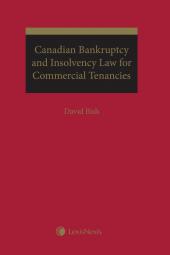Canadian Bankruptcy and Insolvency Law for Commercial Tenancies
One Year Subscription Only Terms
Subscribers receive the product(s) listed on the Order Form and any Updates made available during the annual subscription period. Shipping and handling fees are not included in the annual price.
Subscribers are advised of the number of Updates that were made to the particular publication the prior year. The number of Updates may vary due to developments in the law and other publishing issues, but subscribers may use this as a rough estimate of future shipments. Subscribers may call Customer Support at 800-833-9844 for additional information.
Subscribers may cancel this subscription by: calling Customer Support at 800-833-9844; emailing customer.support@lexisnexis.com; or returning the invoice marked 'CANCEL'.
If subscribers cancel within 30 days after the product is ordered or received and return the product at their expense, then they will receive a full credit of the price for the annual subscription.
If subscribers cancel between 31 and 60 days after the invoice date and return the product at their expense, then they will receive a 5/6th credit of the price for the annual subscription. No credit will be given for cancellations more than 60 days after the invoice date. To receive any credit, subscriber must return all product(s) shipped during the year at their expense within the applicable cancellation period listed above.
Détails des produits
Introducing Canadian Bankruptcy and Insolvency Law for Commercial Tenancies, the first and only book focused exclusively on commercial landlord and tenant law in the context of insolvency proceedings. Written by award-winning bankruptcy and insolvency practitioner, David Bish, this volume offers a comprehensive overview of the legal regime in which these matters play out and features invaluable practical advice and observations from his years of practice. In addition to exploring the need for harmonization between bankruptcy and insolvency statutes, this book examines the jurisdiction and judicial discretion of the courts in making decisions in insolvency matters as well as the constitutional conflicts and privity of estates and of contract issues that can arise when the worlds of bankruptcy and insolvency law and commercial leasing collide.
Featuring valuable content
Canadian Bankruptcy and Insolvency Law for Commercial Tenancies offers specialized, practical information focusing on the key issues that are relevant in a bankruptcy and insolvency scenario involving a commercial landlord and tenant. Bish clearly and cogently analyzes the inherent legal tensions that arise when insolvency law and commercial leasing intersect, giving readers unprecedented insight into this intricate area of the law.
After providing a practical overview of the steps involved in commencing insolvency proceedings – complete with a description of model court orders and comeback clauses – the author delves into the statutory and common law as they relate to issues of particular importance to landlords and tenants when commencing proceedings, including:
- Stays of proceedings
- Rights of occupation and the obligation to pay occupation rent
- Restrictions on interference with, and positive obligations to cooperate with, the debtor/court officer
- The paradigm put in place for the disclaimer, resiliation, repudiation and termination of contracts
- The treatment of fixtures
- Statutory and court-ordered priority charges that may affect landlords
He also provides helpful examinations of a wide range of topics, such as:
- The extent to which insolvent tenants can deviate from lease contracts to the detriment of landlords
- Inventory liquidation sales and the use of agents
- Standard provisions that appear in sale guidelines outlining how a liquidation shall be conducted
- The terms that are included in orders approving liquidations, including examples from liquidations of well-known companies
- The circumstances which trigger the landlord's duty to mitigate, and the calculation of a landlord's claim at common law, in bankruptcy, in Bankruptcy and Insolvency Act proposal proceedings, in Companies' Creditors Arrangement Act proceedings and in receiverships
- The basics of classification of creditors and voting in bankruptcy and insolvency proceedings
- Dealing with the uncommon scenario of a commercial landlord's insolvency and its impact on the tenant
Canadian Bankruptcy and Insolvency Law for Commercial Tenancies contains useful tables and charts, including a summary of the substantive issues dealt with in model orders across Canada and a summary of the provincial statutes governing the assignment of commercial leases by trustees in bankruptcy.
Accessible, essential reading
Because it is written in plain, easy-to-understand English – as opposed to legal jargon – Canadian Bankruptcy and Insolvency Law for Commercial Tenancies would be a useful addition to the library of legal and non-legal professionals alike, as well as anyone who requires an overview of the intersection of bankruptcy and insolvency law and commercial leasing in Canada. In particular, this book should be required reading for:
- Corporate/commercial lawyers and bankruptcy and insolvency lawyers who must advise businesses that have commercial leases and are facing bankruptcy and insolvency issues
- In-house counsel at companies that are in commercial leases (as either tenant or landlord) and are facing bankruptcy and insolvency issues, or at companies that are creditors affected by the bankruptcy or insolvency of a debtor that is in a commercial lease
- Lenders, distressed debt investors, and insolvency, restructuring and turnaround professionals that are looking for a reliable informational resource to guide them in their daily work and assist with particular issues
- Law libraries that want to offer a full collection of research resources to their patrons
Table des matières
Chapter 1: Overview of Canadian bankruptcy and insolvency law
I. Overview
II. Canadian insolvency law
III. The harmonization of bankruptcy and insolvency law
Chapter 2: Jurisdiction and judicial discretion
I. Jurisdiction and the (not so binding) nature of precedent
II. The resulting jurisdictional paradigm in insolvency
III. Principles of jurisdiction in action: The example of Target in Canada
Chapter 3: The intersection of insolvency law and commercial leasing: Constitutional considerations and privity of estates and of contract
I. Constitutional divisions of power
II. Paramountcy of federal law
III. Landlord and tenant constitutional conflicts
IV. The continuing tension with contracts in insolvency law
V. Reconciling legal interests in land: Privity of estate and of contract
Chapter 4: Commencement of proceedings and initial orders
I. The commencement of insolvency proceedings
II. Issues of importance to landlords and tenants at the commencement of insolvency proceedings
Chapter 5: The binding nature of contracts
I. Ending a contract in its entirety
II. Selectively breaching or altering (but not determining) leases
III. Permitted tampering with contract
Chapter 6: Inventory liquidation sales and the use of agents
I. The law of agency
II. The use of sale guidelines
III. Orders approving liquidation
Chapter 7: Sales and assignments of leases
I. Sale procedures
II. Transfer of leases by court order under provincial legislation
III. Transfer of leases via court orders made in BIA or CCAA proceedings
IV. Transfer of leases in receivership
V. Challenges to specific lease provisions by a purchaser: Use restrictions
VI. Continued liability upon sale and assignment of a lease
Chapter 8: Calculation and priority of landlord claims
I. The unique nature of a landlord's claim
II. The duty to mitigate
III. Calculation and priority of a landlord's claim
IV. Prepaid rent, security deposits and landlord claims
Chapter 9: Classification and voting of landlord claims
I. Basics of classification and voting
II. Classification issues for landlords
Chapter 10: Insolvency of a commercial landlord
I. Mortgage enforcement under provincial legislation
II. Impact on tenant of landlord insolvency
 Lexis Nexis
Lexis Nexis 


